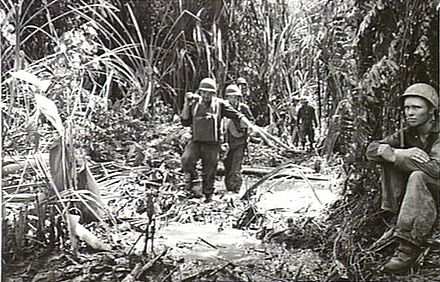During the summer of 1942 both the Japanese and the Allies looked to occupy the northern coast of Papua, the Australian protectorate that made up the eastern part of New Guinea. The Japanese planned to seize Buna, site of an Australian government mission, and then send troops south along the Kokoda Trail, which wound over the rugged Owen Stanley Range, to capture the Allied base at Port Moresby on the southern coast of Papua. From there they could threaten Australia. The Allies, meanwhile, planned to build a base near Buna to support operations against the Japanese strongholds at Lae and Salamaua farther west along the coast as part of their strategic design to seize the Japanese base at Rabaul on the island of New Britain.
The Japanese won the race when, on July 22, troops from the South Seas Detachment landed at Buna. Over the next weeks Japanese forces snaked their way across the Owen Stanleys, continually outflanking Australian defensive positions. But the jungle took its toll, leaving many of their men sick and hungry, and with their supply line under steady attack from Major General George Kenney’s well-run U.S. Fifth Air Force and Australian resistance stiffening as they neared Port Moresby, the Japanese began a retreat (one of their first of the war) to Buna on September 18, reaching it on November 7. There they carved out a narrow fortified zone, approximately sixteen miles long and several miles deep, along the coast. Within it the Japanese had strongpoints at Gona Village, the western anchor; Sanananda Point, in the center; Buna Village; Buna Mission; and Duropa Plantation, the eastern anchor.
In the meantime, General Douglas MacArthur, commander of the Southwest Pacific Area, launched an operation to capture the Buna-Gona zone, utilizing the Australian 7th Division and the American 32d Division, a National Guard division that had yet to see any action or even receive proper jungle training. The Australians pushed north along the Kokoda Trail in pursuit of the retreating Japanese, while a battalion from the 126th Infantry Regiment of the 32d Division crossed the Owen Stanleys on a parallel trail to the southeast. The remaining battalions of the 126th Infantry and the 128th Infantry Regiment were airlifted from Port Moresby to an airstrip about sixty miles southeast of Buna. From there they made their way by land and sea to the Buna sector. By the middle of November both the Australians and the Americans were in place for their final drive to push the Japanese into the sea.
MacArthur, persuaded by intelligence reports that the remaining Japanese in Papua were exhausted and not very numerous, expected an easy victory. In fact, he was in for a tough fight. Rather than the two thousand Japanese estimated to be in the Buna-Gona zone, there were approximately eight thousand. Their defensive positions, consisting of well-camouflaged bunkers and trenches, could be approached only by narrow trails through jungle and swamps. No assault from the sea was possible because of a lack of landing craft and because Vice Admiral Arthur Carpender, MacArthur’s naval commander, would not risk his heavy ships in the waters off Buna out of fear of air attack and the treacherous reefs. To make matters worse, supply shortages, high humidity and temperatures, and jungle diseases quickly caused the morale of the inexperienced Americans to plunge.
If these problems were not enough, Major General Edwin F. Harding, commander of the 32d Division, had only one heavy artillery piece and no tanks, because MacArthur’s staff had decided it would be too difficult to bring them to Buna and keep them supplied and because Kenney had boasted that his planes could substitute for artillery. Kenney had too few planes, however, and his pilots lacked the expertise to provide effective direct support where troops were close to the Japanese. For fire support Harding had to rely on light guns and mortars whose shells bounced off the log walls of the Japanese bunkers, forcing his men to try to knock them out by getting within a few yards of them and lobbing in hand grenades.
The Allied attack began on November 16. After meeting no serious opposition for two days, the Australians ran into heavy machine-gun fire and stalled at the out-skirts of Gona. Another Australian thrust at Sanananda also fell short. At Buna, where the Japanese defensive position occupied an area about three and one-half miles long and three-quarters mile deep and contained about 3,450 naval troops, Harding faced a tactical nightmare. Because the sea made the Japanese flanks unapproachable, Harding had to send the 128th Infantry (his only force available, because the 126th Infantry had been sent to reinforce the Australians) in a frontal assault down two trails that were separated by impassable swamps and jungle. Encountering heavy machine-gun fire on November 19 from cleverly concealed networks of bunkers, both of his attacking forces—dubbed Urbana and Warren—made little headway.
